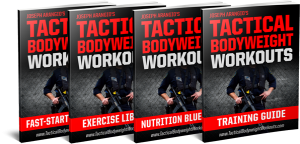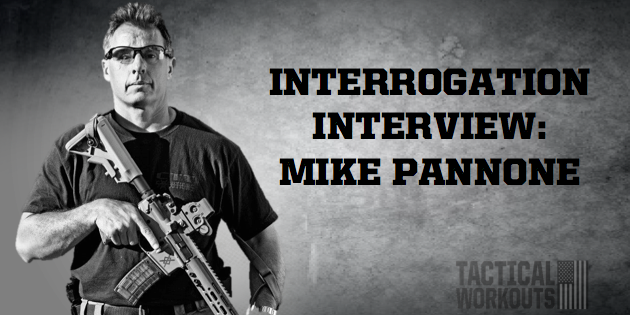Mike Pannone is the owner of CTT-Solutions and is a former operational member of U.S. Marine Reconnaissance, Army Special Forces and 1st SFOD-D (Delta).
He has participated in stabilization, combat, and high-risk protection operations in support of U.S. policies throughout the word as both an active duty military member, and a civilian contractor.
In this Interrogation Interview Pannone shares his in-the-trenches experience about what you should and shouldn’t do when it comes to your physical training program.
JOSEPH ARANGIO: Provide examples of real-world bodyweight-only workouts military operators are doing in the field.
MIKE PANNONE: When in the field or staged in aircraft hangars for prolonged periods I used to do the following workout.
“Hanger Workout” or “1-2-3 Workout”
*100 pull-ups
*200 repetitions of various abdominal exercises with no break
*300 push-ups
This is done either by exercise type (i.e. all the pull-ups, all the abs and then all the push-ups in blocks); but I found doing it as a circuit was a far better all-around workout. The muscle groups get an incomplete rest because they are often supporting the next exercise but the heart (cardio) never does. The concept is an individual timed event and the only breaks are sets of lunges or frog-hops (plyometric) between each set.
Here is my preferred sequence:
1A. Pull-ups
1B. Walking lunges 30 steps
1C. 20 frog-hops
1D. Push-ups
1E. Walking lunges 30 steps/20 frog-hops
1F. Abdominal exercise of choice
Rrepeat until 100/200/300 repetitions respectively are achieved.
When available, I would hold a full 5-gallon water can weighing approximately 45 pounds in each hand for the lunges. It can be done depending on level of fitness in well under an hour and takes nothing but a place to do pull-ups. I do push-ups/abs/ split squats-static lunges in my hotel room when I am traveling and have limited time.
JA: How important is it to train in your full gear, in order to prepare you for the demands of an extra 50-75 pounds of kit?
MP: It is important physiologically and psychologically to become accustomed to it, but only 15-25% of the time or you run an accelerated risk of injury or joint/ligament/tendon degradation. This is something I violated as a young Marine and special operations soldier, and now at 48 I can feel the effects, especially in my lower back, if I allow my core to weaken.
JA: I noticed many eccentric deceleration injuries in military operators, in the literature. Like jumping off a truck bed in full gear, landing and twisting an ankle or blowing out a knee. This is costing the military millions in disability. Any thoughts on how to decrease incidence of this type of injury?
MP: I sustained a Lisfranc injury while conducting a training assault. I was on another operator’s shoulder when he shifted his weight and I fell only about 5 feet, landing on the balls of my feet. At the time I was 5’8” and 200 pounds (a weight efficiency point that I could still run repetitive sub-6 minute miles but was in hindsight excessive) plus 50 pounds of equipment. I landed correctly but the ligaments could not sustain what the muscles could. My natural weight is between a lean 167 lbs to a thicker 180 lbs, so I was carrying 20+ lbs I didn’t really need and I am convinced that was the cause of that injury. This is a large reason why special operations personnel more resemble lean triathlete body types rather than bulky power lifters. Bulking up in Special Operations does not lend itself to the mission set and has traditionally led to injuries in my experience and opinion.
JA: How important is it to train in an "adrenalized" state? In other words, getting your heart rate above 165 bpm in order to prepare for the adrenaline dump that happens when the enemy is trying to kill you.
MP: I call it “physiological stress inoculation” and consider it crucial to becoming acclimated psychologically to what extreme stress to the body does to performance. With repeated exposure to extreme physical stress an individual builds a resistance to its effects and thereby becomes better capable of rapidly regaining physical and mental composure. At peak performance levels this must be achieved with one or two deep breaths in order to take a rapid and accurate shot or conduct a refined task with the necessary level of precision. The only way to get good at that is to push yourself routinely to that level and then force yourself to perform critical tasks.
Even to this day when I practice for USPSA action shooting matches I will do push-ups and pull-ups or lunges and static or split squats at the range to raise my heart rate and degrade my motor functions slightly to see how rapidly I can recover and what level of proficiency I can achieve. Just as a reference, if you don’t feel like you want to vomit while trying to regain your composure…you’re not there yet! I don’t do this all the time but use it routinely as a diagnostic and a way to reacclimatize myself to the stresses and rigors I was once required to be prepared for operationally.
JA: What future trends do you see regarding tactical strength and conditioning?
MP: Interval training and flexibility training I believe will be the future of efficient physical fitness regimens and programs.
Interval training, in my opinion, is the most efficient fitness schedule when you have limited time to work out. Before there was CrossFit and Gym Jones we called it “functional fitness” within special operations. By that we meant fitness in ranges of motion that you will need to function for prolonged periods of time. We did a lot of bodyweight calisthenics, pull-ups, running, swimming and obstacle courses.
Long road-marches with heavy rucksacks were integrated, but were only about 10-15% of physical training from my experience. I did more of that on my own time than was dictated and truth be told, I wish I had not. I could have received as much benefit with only a small amount of additional “load bearing” training without the resulting excessive wear I sustained to my lower back.
From my unit in JSOC, I was exposed to what we called the Gittleson workout (the Head Strength and Conditioning Coach for the University of Michigan’s football program). It was a high-intensity workout where every exercise was done to muscle failure. It requires a partner but it is the blueprint for my current fitness program, and with my limited gym time due to work schedule, it has kept me nearly as fit at 48 as I have ever been. I may not have the running endurance I had at 30 but as far as brute strength overall, I am easily on par or in some areas much stronger.
Flexibility is the key to injury prevention and something that pays unbelievable dividends. It is a long-term endeavor and requires consistent repetition but is crucial to fitness longevity without injury. I know many that have done yoga and swear by it. And not just because of the women in yoga pants! If/when I have the discretionary time to do it there is no question I will. Again, in my experience, nothing will prevent injuries better than flexibility.
JA: List the top-10 items every prepared citizen must own.
MP: Here are my recommendations:
1. Solar/battery multi-ban radio with 4 sets of batteries
2. Quality high output LED flashlight and minimum of 4 sets of batteries (variable power is preferred. Minimum of 1)
3. First aid kit and the training to use it. Take a genuine trauma first aid or wilderness first aid class.
4. Food and water for 1 week
5. Fire-making equipment (lighters are cheap and very reliable) and candles along with outdoor cooking tools (pots, pans, plates cups and dual-purpose metal sporks)
6. Quality large backpack
7. Cutting tools: high-quality locking blade folding knife, large fixed blade knife and medium ax or quality bolo knife plus medical shears and a quality pair of scissors.
8. Duct tape (2-4 rolls) and para-cord (2 spools of 100’ each) and plastic tarps for shelter
9. Quality firearm in a common caliber and minimum of 100 rounds of ammunition
10. Hygiene items necessary to sustain you for minimum of one week
Remember that anything extra you have can be used to help a neighbor or barter for different items you need. The old adage always applies “Two is one and one is none.” Always have a spare!
JA: Please tell the folks about Comprehensive Technical and Tactical Solutions LLC (CTT-Solutions).
MP: CTT Solutions provides the highest level of firearms and tactical training, related program construction and technical consulting available. All training is designed to meet and exceed industry standards and client expectations on a client driven custom basis. CTT-Solutions was a Department Of Homeland Security Small Business Achievement Awardee in 2010 (first year of operation).
 Build Tactical Strength with the Ultimate Tactical Bodyweight Exercise Training Program... Over 100 Exercises. No Gym Required
Build Tactical Strength with the Ultimate Tactical Bodyweight Exercise Training Program... Over 100 Exercises. No Gym Required
Tactical Bodyweight Workouts is based on the teachings of tactical strength and conditioning coach, Joseph Arangio, MS, CSCS.
